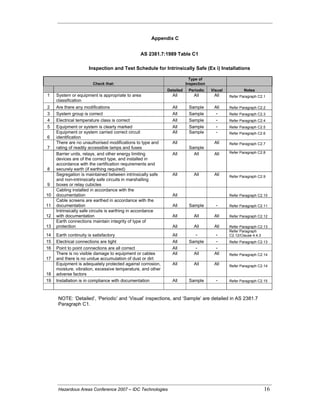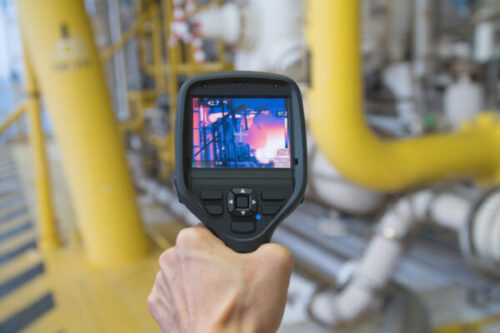The Definitive Guide to Roar Solutions
The Definitive Guide to Roar Solutions
Blog Article
Roar Solutions Can Be Fun For Anyone
Table of ContentsWhat Does Roar Solutions Do?Indicators on Roar Solutions You Should KnowThe Best Guide To Roar Solutions
In such an environment a fire or surge is possible when 3 standard conditions are fulfilled. This is typically described as the "dangerous location" or "burning" triangular. In order to secure installations from a possible explosion a method of evaluating and categorizing a possibly harmful area is required. The function of this is to make certain the right selection and installation of tools to eventually avoid an explosion and to guarantee safety of life.
(https://letterboxd.com/roarsolutions/)
No equipment should be installed where the surface temperature level of the equipment is greater than the ignition temperature of the offered hazard. Below are some usual dust harmful and their minimal ignition temperature. Coal Dust 380C 225C Polythene 420C (thaws) Methyl Cellulose 420C 320C Starch 460C 435C Flour 490C 340C Sugar 490C 460C Grain Dust 510C 300C Phenolic Material 530C > 450C Aluminium 590C > 450C PVC 700C > 450C Soot 810C 570C The possibility of the risk existing in a focus high enough to trigger an ignition will vary from location to location.
Harmful location electrical equipment perhaps created for use in higher ambient temperatures. Field Repair By Authorised Worker: Complex testing may not be called for nonetheless particular procedures might require to be followed in order for the tools to keep its 3rd event ranking. Each piece of equipment with a dangerous score must be assessed independently.
Not known Details About Roar Solutions
The devices register is a thorough database of equipment documents that includes a minimum collection of areas to determine each item's place, technological specifications, Ex-spouse classification, age, and ecological data. This details is critical for tracking and handling the tools efficiently within harmful areas. On the other hand, for periodic or RBI tasting assessments, the quality will be a combination of Detailed and Close inspections. The ratio of Thorough to Close evaluations will be determined by the Devices Threat, which is assessed based upon ignition threat (the chance of a resource of ignition versus the chance of a combustible ambience )and the harmful area category
( Area 0, 1, or 2). This variation will likewise affect the resourcing requirements for work preparation. As soon as Lots are specified, you can develop sampling strategies based upon the sample dimension of each Lot, which refers to the variety of arbitrary equipment products to be evaluated. To identify the needed example size, two facets require to be evaluated: the size of the Whole lot and the category of evaluation, which suggests the degree of effort that need to be used( lowered, normal, or increased )to the evaluation of the Great deal. By combining the group of assessment with the Lot size, you can then develop the ideal rejection criteria for an example, implying the allowable variety of faulty items discovered within that example. For more information on this process, please refer to the Power Institute Guidelines. The IEC 60079 basic suggests that the optimum interval in between assessments must not go beyond 3 years. EEHA inspections will certainly additionally be performed outside of RBI projects as component of set up upkeep and equipment overhauls or repairs. These assessments can be attributed toward the RBI example dimensions within the influenced Whole lots. EEHA evaluations are performed to determine faults in electrical tools. A heavy scoring system is necessary, as a solitary tool might have numerous faults, each with varying degrees of ignition risk. If the combined score of both evaluations is much less than two times the mistake score, the Lot is considered acceptable. If the Whole lot is still thought about inappropriate, it should undergo a complete assessment or justification, which might activate more stringent evaluation methods. Accepted Lot: The sources of any kind of faults are determined. If an usual failure setting is located, extra tools might require maintenance. Mistakes are classified by intensity( Safety and security, Integrity, House cleaning ), ensuring that urgent problems are analyzed and resolved without delay to reduce any type of influence on safety and security or operations. The EEHA data source ought to track and tape the lifecycle of mistakes together with the rehabilitative activities taken. Implementing a robust Risk-Based Evaluation( RBI )technique is crucial for guaranteeing conformity and safety and security in taking care of Electrical Equipment in Hazardous Areas( EEHA) (hazardous area course). Automated Mistake Rating and Lifecycle Monitoring: Easily handle mistakes and track their lifecycle to improve evaluation accuracy. The introduction of this support for risk-based inspection further reinforces Inspectivity's placement as a best-in-class remedy for regulative compliance, as well as for any asset-centric inspection usage instance. If you want discovering more, we welcome you to request a demo and uncover how our service can transform your EEHA monitoring procedures.
The Only Guide to Roar Solutions

In regards to explosive threat, a dangerous area is a setting in which an eruptive environment is present (or might be expected to be existing) in quantities that require unique precautions for the building and construction, installation and use equipment. eeha certificate. In this article we discover the challenges encountered in the workplace, the threat control steps, and the called for competencies to function safely
It is a repercussion of modern-day life that we produce, save or manage a series of gases or fluids that are regarded flammable, and a variety of dirts that are considered flammable. These substances can, in specific problems, create explosive environments and these can have significant and heartbreaking effects. Most of us recognize with the fire triangular remove any kind of one of the three aspects and the fire can not take place, but what does this mean in the context of harmful areas? When damaging this down right into its most basic terms it is essentially: a combination of a particular amount of release or leakage of a specific material or product, mixing with ambient oxygen, and the presence of a source of ignition.
In most instances, we can do little about the levels of oxygen in the air, however we can have considerable influence on sources of ignition, as an example electrical devices. Harmful areas are documented on the dangerous area classification drawing and are identified on-site by the triangular "EX-SPOUSE" indication. Right here, amongst other key details, areas are divided right into three types depending upon the danger, the possibility and period that an eruptive atmosphere will exist; Area 0 or 20 is regarded the most hazardous and Area 2 or 22 is regarded the least.
Report this page